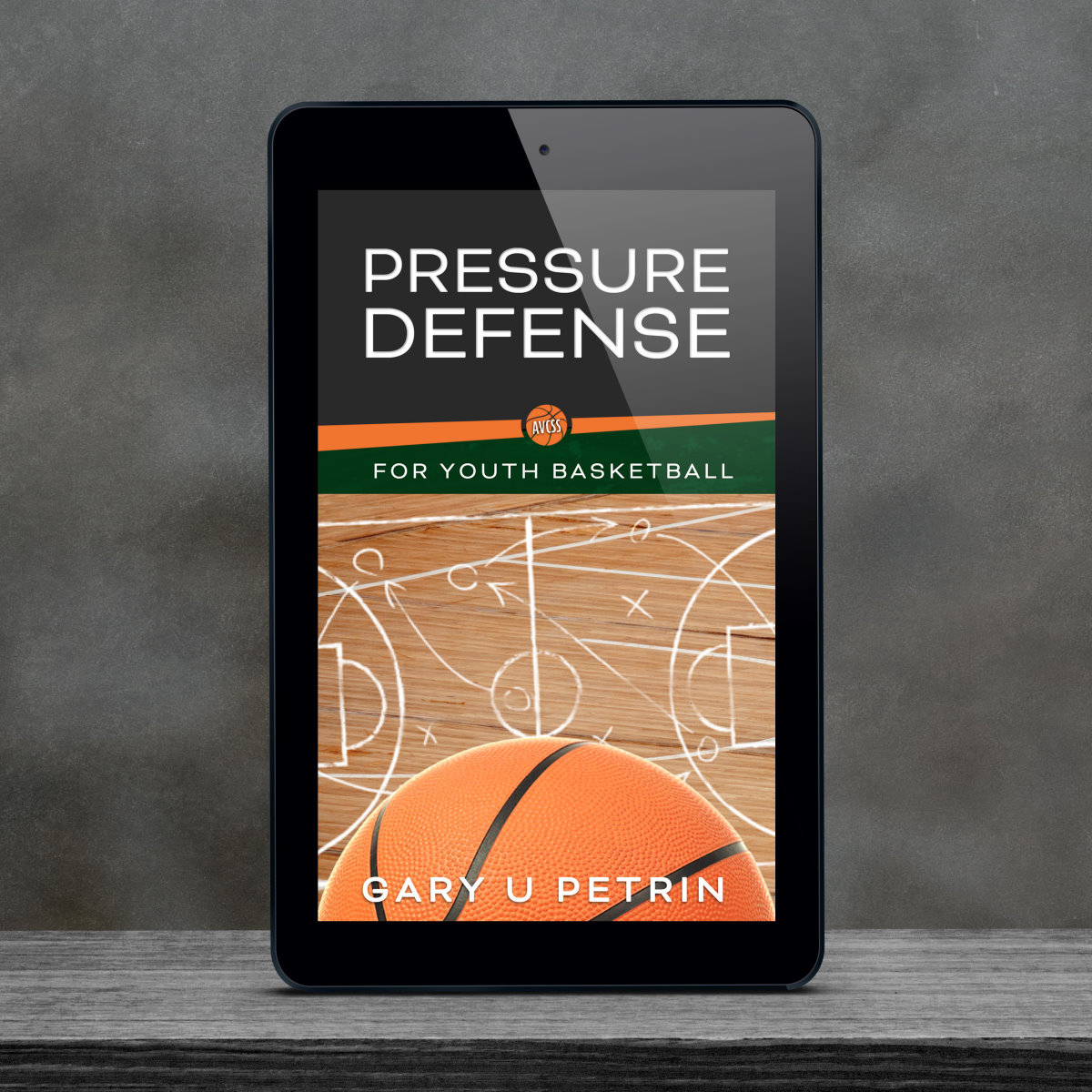The Full Court Press – Pressure Defense
One of the most difficult team skills to teach the younger players
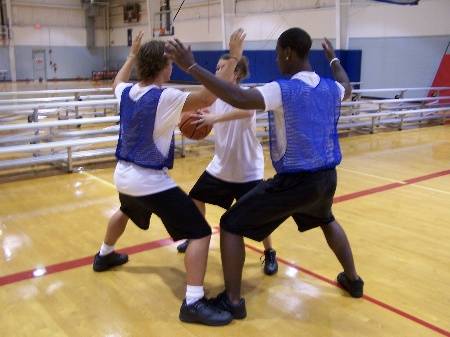
Pressure Defense in Youth Basketball is a critical part of the game. If a full court press is executed properly the other team will not have a chance. If executed poorly the other team may get opportunities to score quickly. Younger players should be introduced to basic “traps” and some easier presses until they are comfortable with the press. A team that presses well can bring down the opposing team to the point of early defeat and sometimes “unintentional” humiliation.
Pressing (full court press) is a good way to get some points from your “defense” – allowing your defense to be your “offense” by scoring points off of steals, turnovers, etc. Learn the proper way to use Pressure Defense in Youth Basketball.
If you want additional information check out the new download AVCSS Basketball publication “Pressure Defense for Youth Basketball”
Important Coaching Tip!
First and foremost, coaches must understand that there are many ways that a full court press can work. Just because your team doesn’t steal the ball every time you press – it doesn’t mean that the press isn’t working! What about turn-overs, wearing down your opponent, creating chaos and frustration, along with the steals. And let’s not forget that your opponent only has 10 seconds to get the ball across half court – if they don’t, it’s your ball. So make sure that you teach your players that there are many ways that the press can help you succeed – it’s not just about the steals…
Basic Press – Teaching Points
The Trap – basically a “trap” is the act of two defenders bringing a “moving” ball under control (by stopping the ball, or by deflecting the ball).
a) Attack the player on the “flight” of the ball (trap as soon as the ball is caught).
b) One player should “force” the ball to the sideline, the other “cut off” the sideline.
c) Always keep hands up and moving, and don’t reach in.
d) Keep knees flexed, don’t stand straight up.
e) Two players should form a trapping “pocket.”
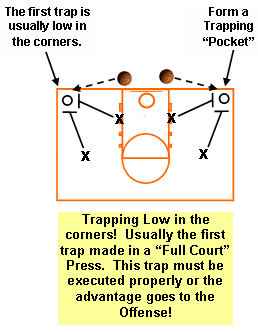
Coach’s must teach their players basics of trapping, and run some drills to develop trapping skills in order to run a good full court press. Trapping is a skill that most coaches neglect to drill in practices. I think that it is because the act of trapping is simple, but the reality is that in a live situation, it’s very difficult to execute a proper trap.

Defenders forming the Trapping “Pocket”
The Best Places to Trap
The best places to trap are in the corners (low corners, and the high corners just past half court). Here is a handout that diagrams the best places on the court to trap.
Best Places to Trap on the Court
Best Places to Trap on the Court – Handout
Passing Lanes – Teach your players to understand that the offense trying to “break” your press will attempt to create “3 passing lanes” on each pass. Use the examples below to assist you with identifying passing lanes.
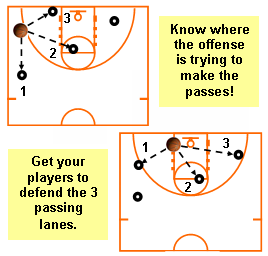
What is Steering?
Steering – There are certain areas of the court that you want to “steer” your opponents ball handlers into. Stay away from “trapping” in the middle of the court. “Steer” the offense to the areas marked “best places to trap” (see diagram). Keeping the ball out of the middle of the court is to the advantage of a press!

The main responsibility of X1 in the example above is to “steer” the ball handler in the direction that they want the player to go. In Example a) X1 is making the ball handler dribble to the left (which is “forcing” the ball handler to use their”weaker” hand to dribble). The younger players will always tend to want to dribble with their strong hand only – so forcing these players to use their weaker hands is the advantage of your defense! In Example b) X1 stays on the “hip” of the offensive player while steering the player into the trap with X3.
Basic Press – Notes / Info / Etc…
1. The corners are the ideal locations for traps.
2. The middle of the court is not a good place to attempt a trap. Younger teams can be successful with a quick trap in the middle (out of a zone, as a surprise tactic), but this usually never works with the older players.
3. The Importance of Setting up your Press Quickly: After a “made” basket the ball is “live” and the offense can pass the ball in right away (without having to wait for the referee to hand them the ball). Your team must set up the press as quickly as possible in order for the press to be effective! Also after a “made” basket, the offense can run the baseline to pass the ball in, adjust your press to handle this situation when it occurs.
4. Passing, not the dribble is the best way for a team to “break the press.” Sometimes the best ball handler on the other team will be able to break the press all by themselves. Although this does not follow the basic principles of press breaking, it is part of the game when it comes to the younger age groups. To understand how to “press” players must also understand “how a press can be broken.”
5. Demonstrate how passing gets the ball up the court faster than dribbling the ball up the court (or watch the video clip below): Have players line up (3-4 players depending on ages) to pass the ball (A), and have 1 player line up with a ball to dribble (B). The coach should blow the whistle to start the demonstration. The players in line (A) should start passing the ball, and the player in line (B) should start dribbling. Ask the players which line got the ball to the basket first? This demonstration should help the players understand the basic point that you are trying to make. A good press will trap properly and defend the pass well – not allowing long passes up the court.
Other helpful Video Clips
with coaching tips, pointers, and examples that pertain to Pressure Defense.
Large / Small Areas of the Court
The 2 Basic Types of the Full Court Press
Basically there are two types of full court presses: The “Zone” set, and the “Denial” set. Both the Zone and Denial sets have specific purposes, but with the younger age groups switching from “one set to another set” during a game can cause “confusion” for the other team.
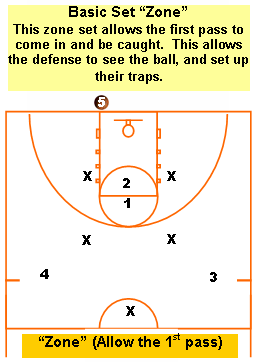
The basic Zone type press (shown above) allows the first pass to come into play, then the defense sets the first trap.
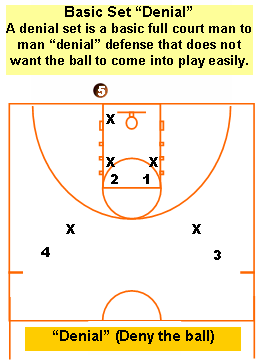
Full-Court Press /Denial Basic
The basic denial type of press (shown above) does not want the ball to come into play. Mainly used when your team is behind and needs to get the ball back and score quickly.
A Basic Half-Court Press
There are also a good number of Half-Court presses that are very effective. I would recommend learning a few half-court presses along with your full-court sets. The more defenses that you throw at your opponent, the better chance you have at succeeding. Here is just one of many half-court presses shown below.

Diagram of the first step…
Step a):
Players are lined up as shown – X5 and X4 at the elbow areas, X3 and X2 up high, leaning towards the sideline, and X1 ready to “attack” and “steer” the ball handler into a trap.
–> X1 should start at the center circle and should not “telegraph” what they are going to do next. (attack the ball handler).
–> X1 should quickly attack the ball handler and force them to a side that X1 dictates. X1 must keep the ball handler away from the middle of the court.
–> X3 and X2 should be ready to execute the high trap (depends on the side X1 steers to).
–> X5 / X4 stay up near the elbow area ready to slide over and cover a passing lane.
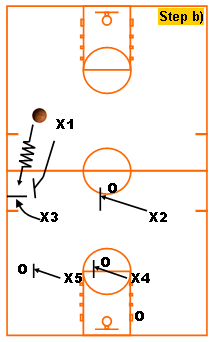
Diagram of the second step…
Step b):
–> X1 has “steered” the ball to the side of X3 and have executed the trap.
–> X5 and X4 must follow the ball to the areas shown. If X5 and/or X4 do not follow the ball, the passing lanes will be open and this defense will break down.
–> X2 Slides over to cover the high mid court area as shown.
Note: The key to this defense is X1 steering the ball into a high trap on either side of the court. All defenders should keep their eyes on the ball. If X1 gets beat in the middle of the court, all players should drop back to defend the basket (quickly).
Coaching “Etiquette” Regarding Pressing
Know when to call off the “Dogs”
What I mean by this, is that a press can end a game very quickly, so you need to know when your opponent is done! I have been in games where I have led by as much as 24 points, stopped pressing, and the other team almost came back. I have been in games where the other team was leading by over 20, and my team came back and won the game. Both of these instances the coaches most likely waited too long to use the press again. Sometimes pulling the Full Court Press too soon can allow the other team to get back in the game and win. How do you know when to stop the full court press – It depends! Use your coaching experience to answer this question!
Call off the Dogs! There are some coaches out there that will press another team into complete submission and embarrassment. I have been in games where we were down by 40 or 50, and the other team comes out and starts pressing again (knowing we are done, and have no chance of winning the game). I have seen this at the younger age groups, middle school level, AAU levels, and at the high school level.
This is not part of the game – some coaches love to beat other teams by 60, 70, or even 80 points, in my opinion, this is not exactly a victory to cheer about. Coaches must incorporate good sportsmanship into the game – we are here to teach the players basketball skills and competition, but also “Life Lessons” (and embarrassing other teams needlessly is not part of any of that).
So when it comes to pressing, use it to win the game, but know when to call off the dogs!

WANT MORE INFO?
Check out our new download AVCSS Basketball publication “Presses / Pressure Defense for Youth Basketball” Lots of information on Traps, Pressing, Full Court Press, plenty of diagrams and the Video Clips to help bring the information to life.
Full Court Press
All the Press Breaking Handouts Here
